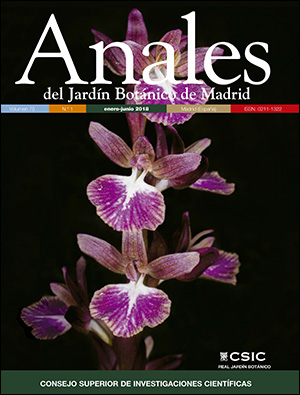Gentianella canoi S.J.Castillo & J.S.Pringle sp. nov. (Gentianaceae), a new species from Peru
DOI:
https://doi.org/10.3989/ajbm.2463Keywords:
Andes, endemic species, Gentianeae, South America, SwertiinaeAbstract
A new species of Gentianella (Gentianaceae) is described from the flora of Peru. Gentianella canoi S.J.Castillo & J.S.Pringle sp. nov., which inhabits high Andean rocky slopes of the Department of Ancash. This new species is related to G. gilgiana (Reimers) Fabris ex J.S.Pringle and G. tristicha (Gilg) J.S.Pringle, with which it shares a caespitose habit, numerous very narrow basal leaves, floriferous stems more than 20 cm high, and widely open corollas. It is differentiated from G. gilgiana mainly by its inflorescences, with 5–11 flowers —vs. 2 or 3—, and corollas 21–28 mm long —vs. 45–55 mm—; from G. tristicha in its opposite leaves —vs. verticillated—; and of both species in their pale yellow corollas —vs. red vermillion in G. gilgiana, lilac in G. tristicha— and in the absence of trichomes in the adaxial surface of the corolla.
Downloads
References
Brako L. & Zarucchi J. 1993. Catálogo de las Angiospermas y Gimnospermas del Perú. Monographs in Systematic Botany from the Missouri Botanical Garden 45: 1–1286.
Castillo S., Salinas N., León B. & Sánchez I. 2006. Gentianaceae endémicas del Perú. In León B. & al. (eds.), El Libro Rojo de las Plantas endémicas del Perú. Revista Peruana de Biología 13 (Supl.2): 339–354.
Fabris H. 1955. Nuevas especies de Gentianella del Perú. Boletín de la Sociedad Argentina de Botánica 6 (1): 45–50.
Fabris H. 1958. Notas sobre Gentianella del Perú. Boletín de la Sociedad Argentina de Botánica 7 (2): 86–93.
Hijmans R.J., Guarino L. & Mathur P. 2012. Programa DIVA-GIS versión 7.5 (Manual). http://www.diva-gis.org [consultada: febrero 2016].
IUCN Standards and Petitions Subcommittee. 2016. Guidelines for Using the IUCN Red List Categories and Criteria v. 12. Prepared by the Standards and Petitions Subcommittee. Página web: http://www.iucnredlist.org/documents/RedListGuidelines.pdf [consultada: junio 2016].
Macbride J.F. 1959. Gentianaceae. Gentian family. Flora of Peru. Publications of the Field Museum of Natural History, Botanical Series 13 (5): 270–363.
Pfanzelt S., Sylvester S.P., Ammann L. & Sylvester M.D.P.V. 2015. Gentianella viridiflora (Gentianaceae), a new species from the Peruvian Andes. Phytotaxa 222 (4): 283–289. https://doi.org/10.11646/phytotaxa.222.4.6
Pringle J.S. 1981. Nomenclatural transfers and taxonomic notes on some South American Gentianaceae. Phytologia 48: 281–285.
Pringle J.S. 1986. A new species and taxonomic notes on Gentianella (Gentianaceae) in South America. Sida 11: 357–369.
Pringle J.S. 1993. New nomenclatural combinations in Gentianella. In Brako L. & Zarucchi J. (eds.), Catálogo de las Angiospermas y Gimnospermas del Perú. Monographs in Systematic Botany from the Missouri Botanical Garden 45: 1255–1256.
Pringle J.S. 2008a. Four new species of peruvian Gentianella (Gentianaceae). Novon 18: 511–516. https://doi.org/10.3417/1997030
Pringle J.S. 2008b. Noteworthy collections: Peru. Madro-o 55 (1): 91-92. https://doi.org/10.3120/0024-9637(2008)55[91b:P]2.0.CO;2
Pringle J.S. 2011. Five new species of South American Gentianella (Gentianaceae). Novon 21 (1): 78–89. https://doi.org/10.3417/2008086
Pringle J.S. 2012a. Two taxonomic innovations in South American Gentianella (Gentianaceae). Novon 22 (2): 217–219. https://doi.org/10.3417/2011034
Pringle J.S. 2012b. Gentianella weigendii (Gentianaceae), an unusual new gentian from Peru. Novon 22 (1): 70–74. https://doi.org/10.3417/2011008
Pringle J.S. 2014a. Morphological Characteristics of the Family Gentianaceae. In Rybczy?ski J.J. & al. (eds.), The Gentianaceae volume 1: characterization and ecology. Springer, Berlín y Heidelberg.
Pringle J.S. 2014b. New species and nomenclatural transfers in South American Gentianella (Gentianaceae). Annales Botanici Fennici 51 (1–2): 117–124. https://doi.org/10.5735/085.051.0116
Pringle J.S. 2016. New South American species of Gentiana and Gentianella (Gentianaceae). Novon 24: 389–398. https://doi.org/10.3417/2015009
Pringle J.S. 2017a. Especies ginodioicas de Gentianella (Gentianaceae) en Colombia, Ecuador y Perú, con la descripción de G. quipuscoana, nueva especie del Perú. Arnaldoa 24 (1): 9–18. Página web: http://journal.upao.edu.pe/Arnaldoa/article/view/683 [consultada: noviembre 2017].
Pringle J.S. 2017b. Four New Species of Gentianella (Gentianaceae, Gentianeae, Swertiinae) from Peru, with a Review of the Taxonomy of the Genus. Novon 25: 451–466. https://doi.org/10.3417/2016001
Pringle J.S. & Grant J.R. 2012. Two new species of Gentianella (Gentianaceae) from Peru. Brittonia 64 (3): 282–288. https://doi.org/10.1007/s12228-012-9239-z
Smithsonian National Museum of Natural History. 2016. Smithsonian National Museum of Natural History, botany collections. Página web: https://naturalhistory.si.edu/ [consultada: enero 2016].
Struwe L., Kadereit J.W., Klackenberg J., Nilsson S., Thiv M., von Hagen K.B. & Albert V.A. 2002. Systematics, character evolution, and biogeography of Gentianaceae, including a new tribal and subtribal classification. In Struwe L. & Albert V.A. (eds.), Gentianaceae: Systematics and Natural History: 21–309. Cambridge University Press, Cambridge.
The Field Museum. 2016. The Field Museum, botany collections database. Página web: https://www.fieldmuseum.org [consultada: enero 2016].
Thiers B. 2016. Index Herbariorum: A global directory of public herbaria and associated staff. New York Botanical Garden's Virtual Herbarium. Página web: http://sweetgum.nybg.org/science/ih/ [consultada: noviembre 2016].
UICN. 2012. Categorías y Criterios de la Lista Roja de la UICN, v. 3.1, ed. 2. Gland, Suiza y Cambridge, Reino Unido. Página web: http://cmsdocs.s3.amazonaws.com/keydocuments/Categories_and_Criteria_es_web%2Bcover%2Bbckcover.pdf [consultada: junio 2016].
Published
How to Cite
Issue
Section
License
Copyright (c) 2018 Consejo Superior de Investigaciones Científicas (CSIC)

This work is licensed under a Creative Commons Attribution 4.0 International License.
© CSIC. Manuscripts published in both the print and online versions of this journal are the property of the Consejo Superior de Investigaciones Científicas, and quoting this source is a requirement for any partial or full reproduction.
All contents of this electronic edition, except where otherwise noted, are distributed under a Creative Commons Attribution 4.0 International (CC BY 4.0) licence. You may read the basic information and the legal text of the licence. The indication of the CC BY 4.0 licence must be expressly stated in this way when necessary.
Self-archiving in repositories, personal webpages or similar, of any version other than the final version of the work produced by the publisher, is not allowed.















